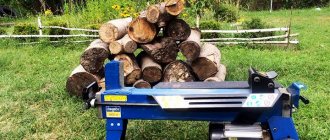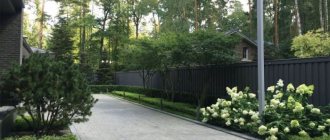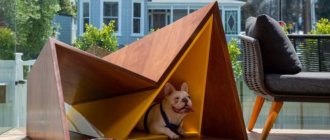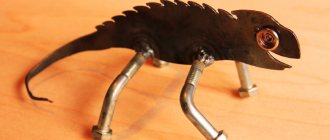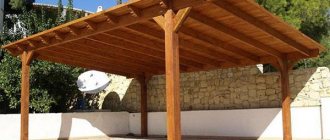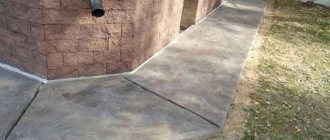SHARE ON SOCIAL NETWORKS
FacebookTwitterOkGoogle+PinterestVk
In winter, any owner of a summer house or private house is faced with the need to clear snow from the yard, paths, driveway to the house, and also the roof. Using special equipment, which many companies produce, this can be done easier and faster. But there is another option: a DIY snowblower. Anyone who is familiar with the operating principle of snow blowers and has certain technical skills can assemble the device themselves.
It is possible to build a snowblower that can effectively cope with cleaning the local area yourself.
Drawings and diagrams
To assemble snow blowers, you can use drawings that are easy to find on the Internet, or start developing your own version based on local conditions.
There are four types of snowblowers:
- Bulldozer. Wheels with a blade mounted at the front.
- Auger. In it, snow is gradually captured by rotating belts and moved to a pipe through which it is thrown out.
- Fan-blade. Using special blades, the sticky snowflakes are directed to the fan, lifted by the blades to the pipe and flew out.
- In air-fan . It works like a vacuum cleaner. The snow mass is drawn in by a strong stream of air and thrown out into the street.
In cities, all these types of cleaning equipment are used, but in rural areas it is difficult to make the air-fan type, since a very powerful engine is needed to suck up snow. Therefore, the article discusses the creation of only the first three options.
The most popular models in different price categories
At the end of the article, we will provide a comparative table with prices of the most popular manufacturers of snowblowers, both budget and premium. You can buy a snowblower in specialized stores of country special equipment.
| Manufacturer | Model | price, rub. |
| Budget snow blowers | ||
| Interskol | SMB-650E | 45 220 |
| Hyundai | S5560 | 43 490 |
| Patriot | PRO 655 E | 41 450 |
| Mid-class snow blowers | ||
| Husqvarna | ST 224 | 99 990 |
| Champion | ST1074BS | 87 800 |
| MTD | SMART ME 61 | 72 200 |
| Premium snow blowers | ||
| Husqvarna | ST 330PT | 239 990 |
| SNAPPER | SNM924E | 139 990 |
| HONDA | HSM1390IKZE | 455 510 |
Required tools and materials
Before choosing materials and making the device, you should remember that the chainsaw engine has little power. You should not use the unit to clear ice or heavily frozen snow to avoid damage.
First you need to think about what to make the cleaner from and what devices to use. It is not difficult to guess that different types of work will require different materials. They will be indicated in the instructions for the manufacture of a particular design.
What tools should you use:
- welding machine;
- hammer, pliers, screwdriver;
- different keys;
- file;
- grinder and drill;
- hacksaw;
- vice.
Principle of operation
The power unit starts up and rotates the auger, which, in most cases, has a spiral shape. In rotary snow blowers, the guide elements are straight.
Thanks to him, the snow is raked and thrown to the side. Moreover, this operating principle is relevant for all models, regardless of cost. As the price increases, headlights, heated grips and other extras are added.
Snow blower with blade
The easiest thing is to assemble a motorized snow blower from an already finished product, slightly altering it. But you can do it differently and do it yourself.
In the first case, the basis of this unit is a conventional industrial-style manual cleaner with two or four wheels. In the second, all the parts are obtained or made by hand.
Materials for assembling a snow blower
- metal sheets 2, 3 or 4 mm;
- pipes with a caliber of 50-70 mm;
- bearings (local);
- frame squares;
- wheels;
- axles;
- washing machine tank, boiler or pan;
- sprockets or gears;
- chains or belts;
- bolts, nuts;
- electrodes.
Snow blowers from industrial designs
The unit is made from mobile rather than hand-held devices. There are two options for such devices. The first of them has a stationary axis, and the second has a rotating axis. Both devices (or the rotating rod) have a fixed blade.
It is better to choose an option with one or two axles that rotate, and the wheels are rigidly fixed to them. Then minimal modification will be required.
Step-by-step instruction:
- One or two wheels are removed (front ones if the snowplow is biaxial).
- A sprocket, for example, from a motorcycle, is welded (or otherwise strengthened) onto the freed axle. It is advisable to install it closer to the hub of one of the wheels.
- The structure is being put back together.
- A plate is screwed to the handle (if the option is single-axis) or to the frame. A chainsaw is attached to it so that the chain draped over the welded sprocket is properly tensioned.
If the axle is welded tightly, you need to do the following:
- Remove the wheels.
- Choose an axle or a thick rod for them.
- Grind the hubs or cups so that the wheels “sit” tightly.
- Weld metal corners with holes for the new axle to the frame.
- Strengthen the driven sprocket (from a motorcycle, for example).
- Assemble the structure - insert the axle into the corners (you don’t have to cut off the old one if it doesn’t interfere) and install the wheels.
- Attach the chainsaw to the frame or handle.
When operating such a unit, you will not need to waste a lot of energy. The saw motor will create the required force.
Homemade bulldozer type cleaner
This option repeats the previous two. The difference is that most of the parts and components are made independently.
To make it you need to get the wheels. You can borrow them from an old bicycle. Or remove one or two complete wheelsets from a wheelbarrow or any end-of-life vehicle. Then select an axis for them on which they will be permanently mounted.
The whole job is as follows:
- A single or biaxial frame is welded from ordinary or profile pipes.
- Corners with holes are welded to it.
- An axle with a pre-fixed sprocket is inserted into them.
- The wheels are being put on.
- Weld stationary pipes or a rotating mechanism for the blade.
- Install the plate with a chainsaw.
Making a homemade blade
This part of the purifier is made of metal sheets, a barrel, a large-diameter pipe or some kind of tank (from an electric heater, for example).
The main dimensions are selected independently depending on the power of the chainsaw. It is not recommended to make a blade more than a meter long, since the engine may not be able to withstand such a load.
When making a dump from sheets, they are pre-lined. Then the parts are cut out and welded together. This snowblower assembly can have any shape.
When making a blade from a cylindrical blank, it is cut as shown in the figure. If the unit is made from a pipe, then sides are installed on the sides. At the bottom (for rigidity) a knife made of a long, pointed strip of metal is riveted.
Types of snow removal equipment for the home with your own hands
Snow removal machines are designed for mechanical removal of snow cover in the required area. Their functions include collecting snow mass and throwing it back to the collection point. The engine that powers the car can be electric or gasoline. And the snow removal equipment itself is divided into self-propelled (with tracked or wheel drive), manually controlled, single-stage and two-stage.
To independently assemble such garden equipment, you can use a chainsaw engine, an electric motor or a walk-behind tractor, as well as various improvised materials that everyone probably has on their farm. Before you make a snow blower with your own hands, you should familiarize yourself with the types of such equipment and choose an acceptable option for yourself.
The choice of snow blower design depends on many factors, one of which is the area of the area that is supposed to be processed.
Electric snow blowers can clear small areas near your home, such as porches or narrow walkways. Such a unit is not suitable for clearing large areas of snow cover. In addition, its operation is not effective if there is ice or significant snowdrifts. On the other hand, such equipment is quite compact, easy to operate and convenient to store.
Gasoline-powered self-propelled snowblowers do an excellent job of removing large amounts of snow from large areas. Moving independently, these vehicles have excellent maneuverability and a long ejection range. The equipment is quite large in size, but does not require any physical effort during operation.
Before you make a manual snow blower with your own hands, you need to keep in mind that non-self-propelled models are designed for cleaning small areas of freshly fallen snow up to 25-30 cm thick. They are mainly used for daily cleaning of sidewalks, garden paths and flat roofs. Such devices are quite maneuverable, however, when removing a dense layer, it will be difficult to control the equipment, since you will have to push not only the device, but also the thickness of the snow in front of it.
DIY snow blower with a chainsaw engine
Helpful advice! When assembling a non-self-propelled snow blower for your home with your own hands, you should use the lightest possible parts, since the equipment will work due to human efforts.
Screw option
A device with a blade has drawbacks, and the main one is the waste of time and effort to remove the layer of snow picked up by the blade. Often it is left right next to the road, creating high snowdrifts, which is not always acceptable.
The version of the snow blower with an auger will allow you to get rid of even roadside sediment, because its design provides for the throwing of the captured mass over a distance of several meters. This will help clear the yard or street completely, leaving the piles next to the fence.
This option is welded or screwed from the front to a frame with wheels, which can be removed from an old wheelbarrow, for example.
Another design is a wheelless version, controlled by a tube. The body is mounted on a frame made of angles, from the bottom of which skis are screwed.
Main components and materials of both options:
- box - welded from sheets of metal;
- central shaft - is a ¾-2 inch pipe;
- gripper (scapula) - iron plates or pieces of channel;
- supporting elements;
- auger - made of rings or tape;
- motorcycle sprocket;
- ski made of plates or pipes;
- frame made of corners;
- bearings;
- a pipe for throwing out snow - you can take it from the stove.
Screw assembly sequence:
- 4 rings and 6 support plates are cut from roofing sheets or other metal.
- Six strips are placed on the shaft and welded to it at an angle of 90°. Then the sprocket is strengthened and the bearings are pressed in.
- Two blades made of plates are inserted between the middle guides. They are welded to the shaft and to the supporting elements. If pieces of channel bars are used as gripper blades, they are rotated 180° relative to each other.
- The rings are cut, bent and welded so that two intersecting spirals are obtained.
You can straighten them in two ways:
- Clamp the middle part in a vice, grab one edge with pliers and pull it to the side. Do the same with the other end.
- Weld one edge to the support element at the blade and stretch it.
If the rings are made of thick material and it is difficult to grasp them with pliers, then you can use two clamping devices, such as a vice.
After making the auger, a sheet of metal is laid out and the box is welded. A hole is cut out in its middle part for a pipe to throw out snow. You can make it yourself or use one already prepared from an iron stove. Some craftsmen use plastic ones.
Then a rectangular hole is cut in the body opposite the sprocket to allow the chain to pass through. The box is installed on a frame with runners or wheels and the chainsaw is strengthened.
Which is better: buy or make it yourself
There are several factors that will help fundamentally resolve this issue. The first is the area of the territory and its landscape. If you are ready to spend money on a powerful engine, and are absolutely sure that you can assemble a stable structure with a durable body, you can do it yourself, otherwise it is better to pay attention to ready-made samples.
A gas-powered snow blower allows you to clear larger areas more efficiently. However, such models are more finicky in care
Some factory models are equipped with a plug-start function - in other words, they have a built-in socket for an extension cord. This solves the problem of starting a snow blower even in severe frosts. In addition, it is necessary to assess the amount of work, determine the purpose of the device, and take into account your capabilities:
- Type. If you are not ready to periodically play the role of a draft horse, then it is better to give preference to self-propelled models.
- Time of use of the unit . If you are purchasing a snow blower for your dacha and plan to use it from time to time, there is no point in spending money on an expensive model. In this case, you can build a snow blower with your own hands, while saving on the purchase of an engine and materials.
- Price . In this case, the one who pays is right. Sometimes it is easier and cheaper to make a snow blower yourself and expand its functionality than to buy a ready-made, but more simplified model.
- Functionality and additional features. Study the following points: control and launch method, travel speed, bucket volume and engine power, maximum distance for throwing snow and, of course, fuel consumption.
Gasoline snow blowers are larger than electric snow blowers. And one more thing - the cost of a gasoline car is almost twice the price of its battery-powered counterpart.
Let's take a closer look at the operating principle and operation of different types of machines.
Fan unit
An industrial version of this type (Blizzard) has long been used on the farm by many people. But you can assemble it yourself.
This snow blower is very reliable and does a great job.
It consists of a small number of parts:
- The knives perform two functions: they cut the snow and direct them to the fan.
- A rotor with blades captures layers of stuck together snowflakes, spins them and pushes them out at high speed through a hole in the body.
- The pipe serves as a guide for the flow of thrown snow.
To manufacture such a unit, the following materials are required:
- sheet iron 1-3 mm for the body and blades and 5-10 mm thick for the blades;
- shaft for rotor;
- star;
- squares for the ski option or wheelset;
- pipes for making handles.
The procedure for manufacturing the structure
First, they make a body with knives. To do this you need:
- Determine the diameter of the fan and calculate the circumference using the well-known formula L=πD.
- To the resulting value, add an allowance of 1 cm if using a welding machine and 2 cm when connecting the edges with bolts or rivets.
- Then you need to cut a strip of length L+ (1 or 2 cm) of the required width (for example, 10-15 cm) from the sheet.
- Bend the workpiece on a mandrel and weld it. Or drill holes in the overlap area and connect in another way.
- Draw on a sheet of paper a circle with diameter D for the back wall of the case and triangular-shaped knives with a rounding at one corner.
- Weld all the workpieces in place.
Execution of a rotating assembly:
- A 20-30 cm long shaft is placed on the bearing so that 5-6 cm peeks out on one side. To manufacture it, the services of a turner may be required. If the farm has the necessary part with a bearing, then you can use it.
- Determine the center of the circle (back wall) and drill it with a drill whose caliber is 3-5 mm larger than the diameter of the shaft.
- Measure the external dimensions of the bearing and cut out a cup for it from iron. It should have tabs in order to drill them and secure this part with screws.
- A glass is placed on the bearing, and a pipe of suitable diameter is pressed onto the shaft or mounted and clamped with screws.
- Blades are welded to it - plates made of thick iron.
- The rotating assembly is fixed from the inside of the housing so that 5-6 cm remains outside.
- An asterisk is welded onto this “tail”.
At the very end, a drawing of the pipe is made and a blank is cut out, which is bent and welded. A hole is made on top of the body (in the center or slightly to the side). Then the pipe is strengthened. It is advisable to make its top rotating so that you can direct the flow of snow where needed.
The entire structure is mounted on a frame (front) with skis or wheels. The chainsaw is strengthened, as in the previous ones.
Comparative analysis of electric and gasoline snow blowers - disadvantages and advantages
Let's look at the features of electric and self-propelled gasoline snow blowers.
Designs with an electric motor.
Even a woman can operate such an electric machine
Usually this is a medium-weight design - up to 75 kg, equipped with a low-power engine, with the ability to connect to the electrical network.
Advantages:
- compactness - both in use and storage;
- maneuverability;
- Suitable for clearing freshly fallen snow;
- environmentally friendly, as there are no gas emissions.
Flaws:
- Do not clear areas with heavy snow cover. The snow thickness should not exceed 30 cm;
- not suitable for clearing surfaces of ice;
- depends on the cable length or battery capacity.
Structures powered by liquid fuel . They are based on a gasoline engine, often from a chainsaw or trimmer.
Gasoline models are used to clear streets and parks
Advantages:
- high power and performance;
- easily copes with large deposits of snow and ice;
- autonomous movement, does not depend on external power sources.
Flaws:
- complex equipment;
- large overall dimensions;
- heavy weight of the device;
- difficulty of repair.
Precautionary measures
The main danger is the puppy, which is capable of not only wrapping clothes around itself, but also hitting or even injuring an arm or leg. When clearing snow, a number of rules should be followed:
- Wear warm clothes and non-slip shoes.
- Wear ear protection, gloves and goggles.
- Do not direct the flow of snow towards people or cars.
- If the snow blower is electric, then do not forget about the cable.
You should also remember the dangers when refueling the unit, because mistakes made can lead to a fire or explosion of the fuel.
A snow blower can work not only in winter, but also in other seasons. The fan version (if placed with the opening facing up) can be used for threshing corn. Or supplement it with pipes and use it as a forced ventilation device.
Construction of Electrical Assembly
The electric design of the snow collector is most suitable for summer cottages where snow needs to be removed rarely and in small quantities. Most often, instead of a screw, such machines are equipped with one rotor running on a fan. After capturing the snow with special blades, the fan blades begin to mix the snow with air, and then, under pressure, throw it in a certain direction using a hose. A rotary snow blower can only cope with loose and newly fallen snow.
This rotor design is simple, so anyone can make it following the main drawings. Creating a device:
- A special metal disk is used for the impeller; steel strips are welded onto it onto the blades. Their number can vary from 2 to 5 pieces. The shaft is turned on a lathe from a steel rod. Along with the hubs, several bearings are placed on it.
- For the snail body, a part of a metal barrel with a height of 150 mm is cut off. On the side you need to cut a small hole where the pipe for mounting the sleeve will be placed. A hole is drilled in the center of the bottom, and a special rotor shaft is inserted into it so that it moves inside the cochlea. A special impeller is put on it. The bearing hubs are attached to the bottom with bolts from the outer surface of the volute. On the back side of the structure body, two rectangular sheets are welded. The guide vanes will efficiently capture excess snow, the fan will suck in, grind and throw it to the sides, thereby cleaning the area.
- The finished device with a rotor is placed on a frame, combined with a belt drive by an electric motor, and special wheels from a wheelbarrow are used as the running gear.
A few final tips
- If you are making your own snow blower, add bushings to the design to protect the engine from getting hit by stones or pieces of hard ice.
- It is better to use a belt drive for the machine, as there is less risk that the motor will jam if hit by a stone.
- In winter, it is better to keep the device warm, so it will start up faster.
- On frosty days, use thin gear oil; it will not thicken quickly in the cold.
If you have an old chainsaw, a powerful trimmer or a walk-behind tractor in your home, there is no need to buy a separate snow blower. You can buy a ready-made auger or make it yourself and adapt it to any of these devices. Share your experience if you have already done something similar!
Mounting on the engine block
The easiest snow collector to create is considered to be mounted on a walk-behind tractor. If there is a traction device in the yard, then why make another machine with a drive in the structure. To do this, you need to create a special auger mechanism with special blades for throwing snow as a hitch . The snow receiver body is placed on the frame, and skis are attached to the bottom. Special fasteners are installed on the back of the frame, with the help of which the coupling will occur with the walk-behind tractor and attachments.
The drive is carried out using a belt drive. You can set the rotation speed of the auger yourself by selecting pulleys of different diameters. If this cannot be done, then a special intermediate gearbox can be created between the auger nozzle and the walk-behind tractor. It will reduce the speed to the desired frequency.
A self-made snow blower will hardly differ in performance from its factory-made counterparts, and will cost the user much less than a purchased model. The auger-rotor unit is much more difficult to create, but has a high performance indicator. This device should be used by residents of regions where there is a large amount of precipitation.
How to make a snow shovel on a bicycle wheel
It is impossible to clean narrow winding paths with a wide two-wheeled shovel. For such purposes, it is optimal to consider another device. It is made from one large diameter bicycle wheel.
A single-wheeled shovel is convenient for clearing snow from narrow paths
First, they create the shovel itself. You can take a ready-made factory-made plastic scoop. It is mounted on a long handle made of an aluminum tube. A T-shaped handle is attached to the other end for a two-handed grip. A hinge mechanism with a bicycle wheel is attached to the handle. The lever should rotate freely on the axis so that it is convenient to lift the shovel and throw away snow. The location of the hinge on the handle is determined individually, which depends on the diameter of the wheel.
How to make a snow shovel on wheels from a washing machine
Many still have Soviet washing machines in their dacha sheds. Their body is made in the shape of a barrel. If you cut it, you get a good blank for a ladle. If you need a narrow shovel, you can find even better material for it. The tank is hidden inside the washing machine body. It is made of stainless steel or aluminum alloy. The tank is opened in the same way with a grinder, cutting out a segment of the required size.
The shape of the Soviet washing machine is identical to the barrel
The downside of the washing machine body is the thin tin. To prevent it from bending under the load, the ends of the semicircular bucket are sewn up with metal. You can install two wheels on the frame, and two on the shovel itself. The front wheels use a smaller diameter. Additionally, they will act as a limiter that prevents the edge of the bucket from cutting into the ground.
The stability of the snow removal tool will be given by a load of bricks placed between the frame and the bucket.

